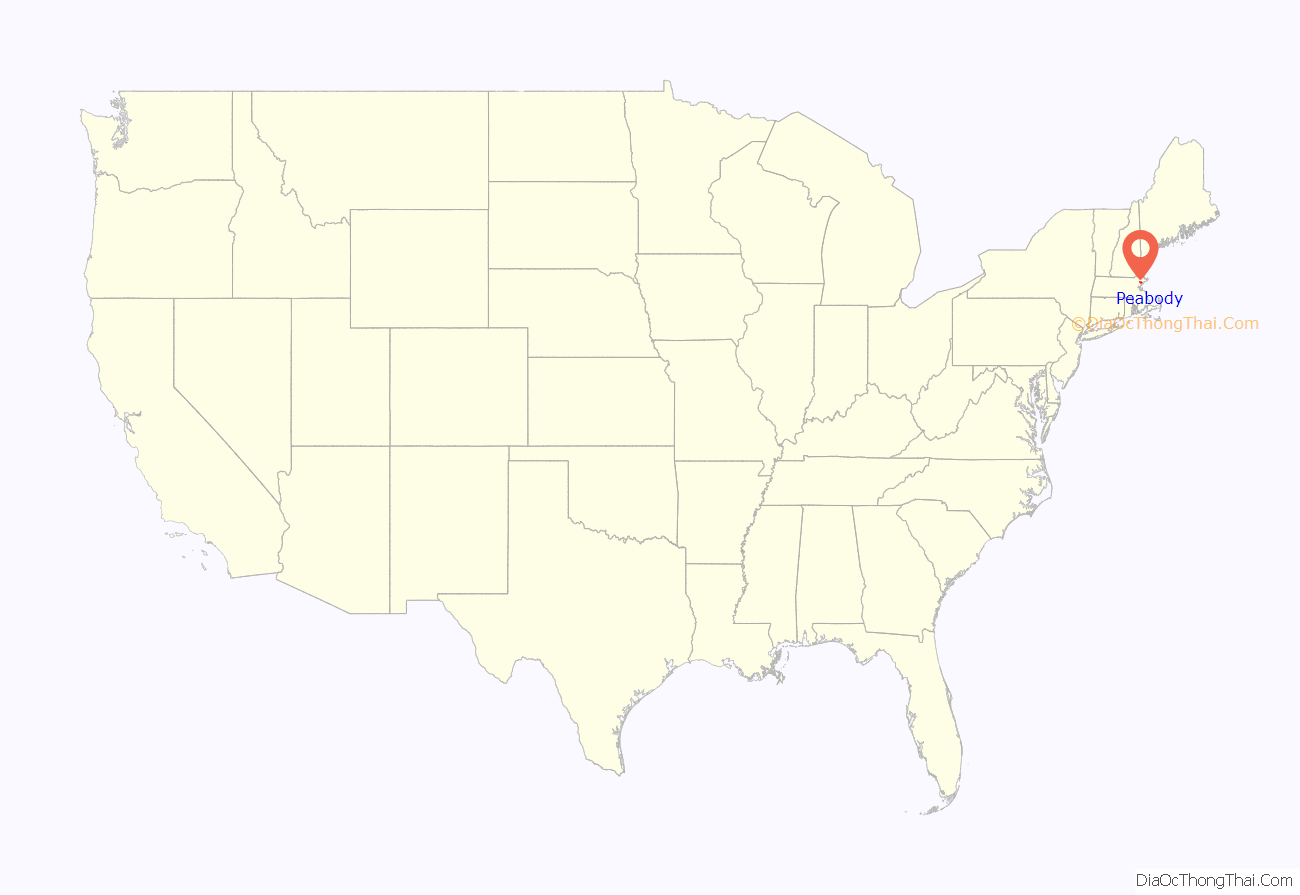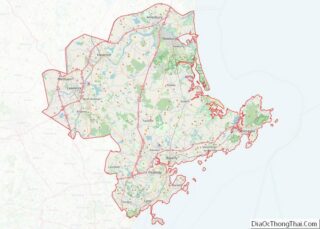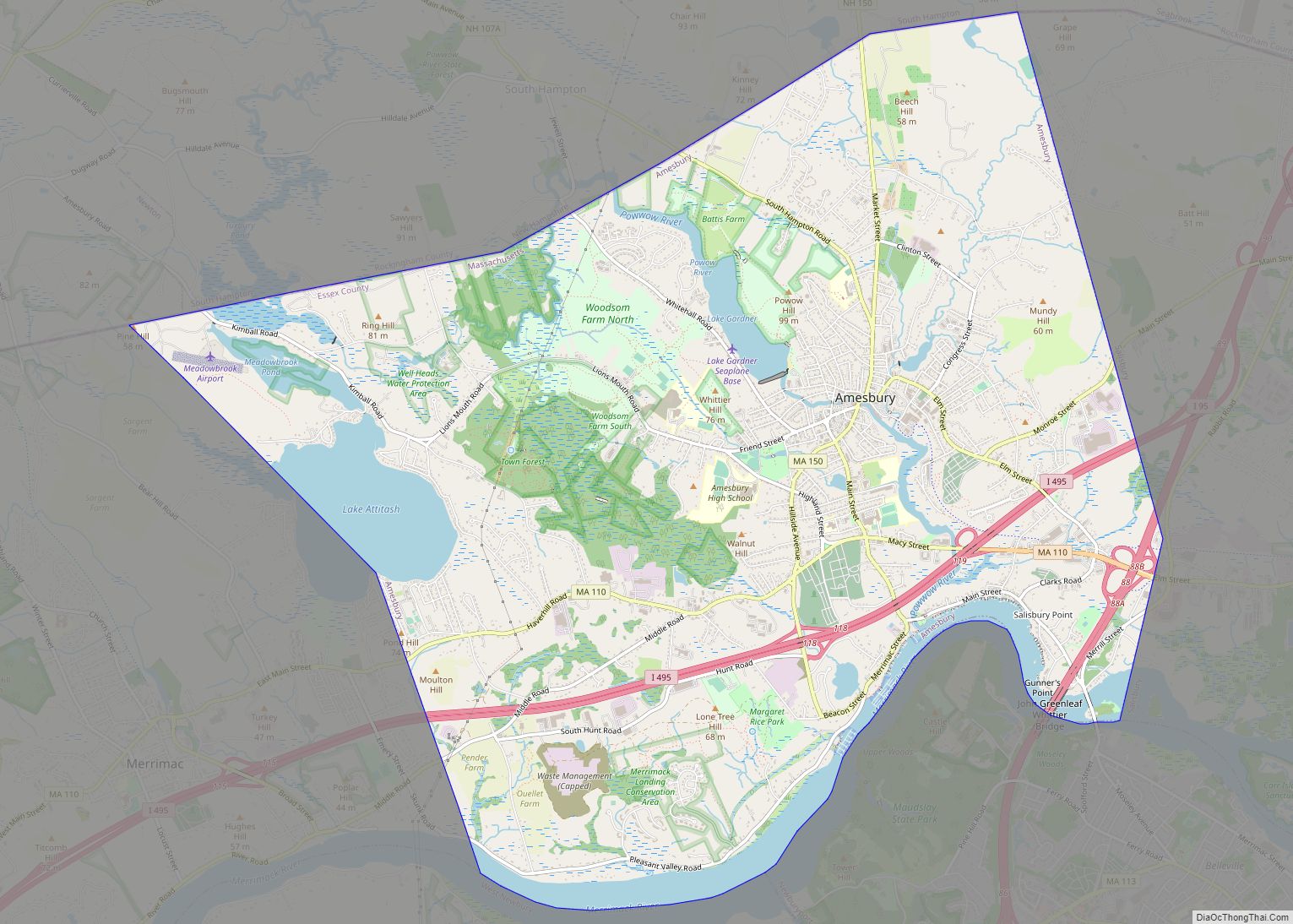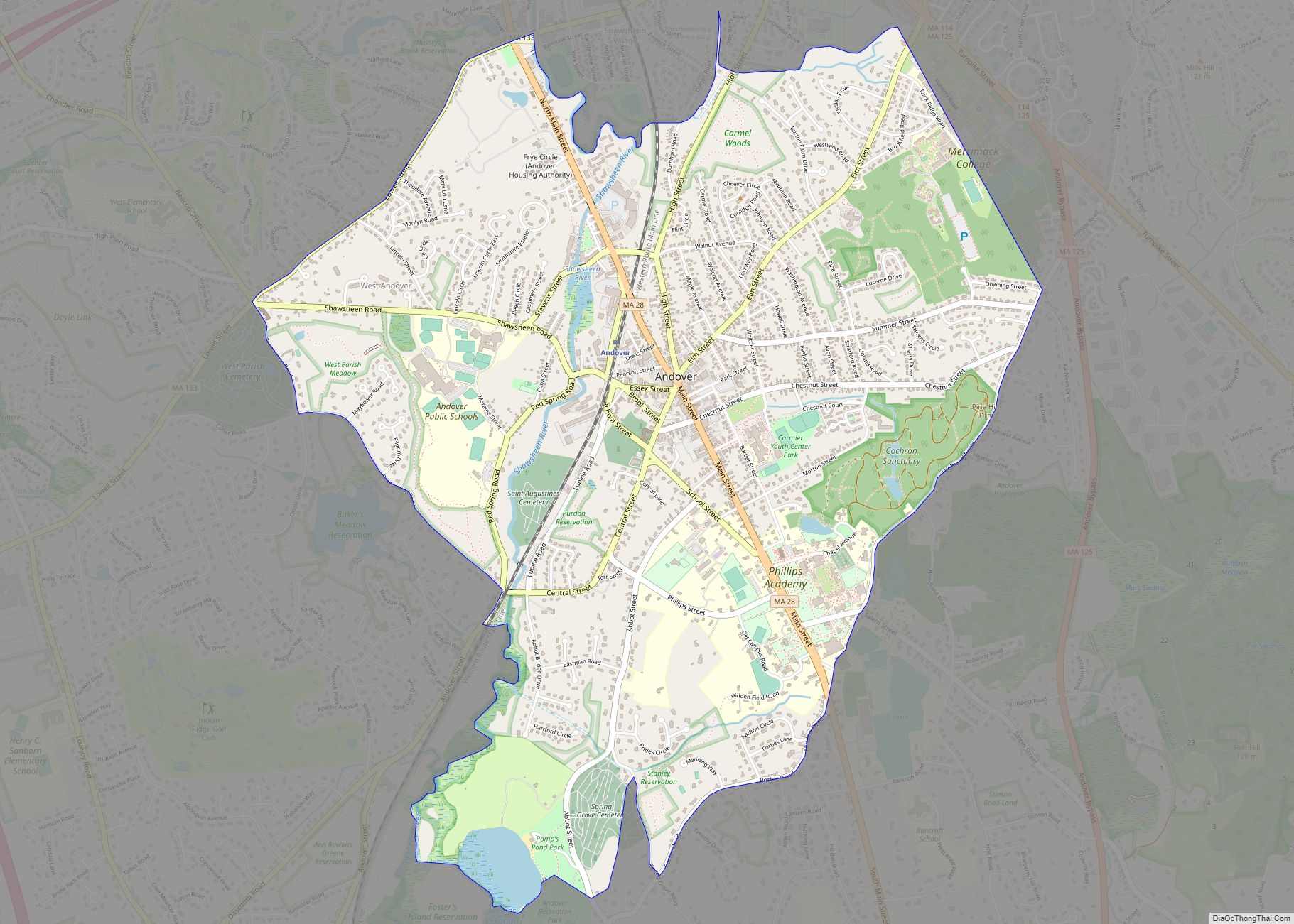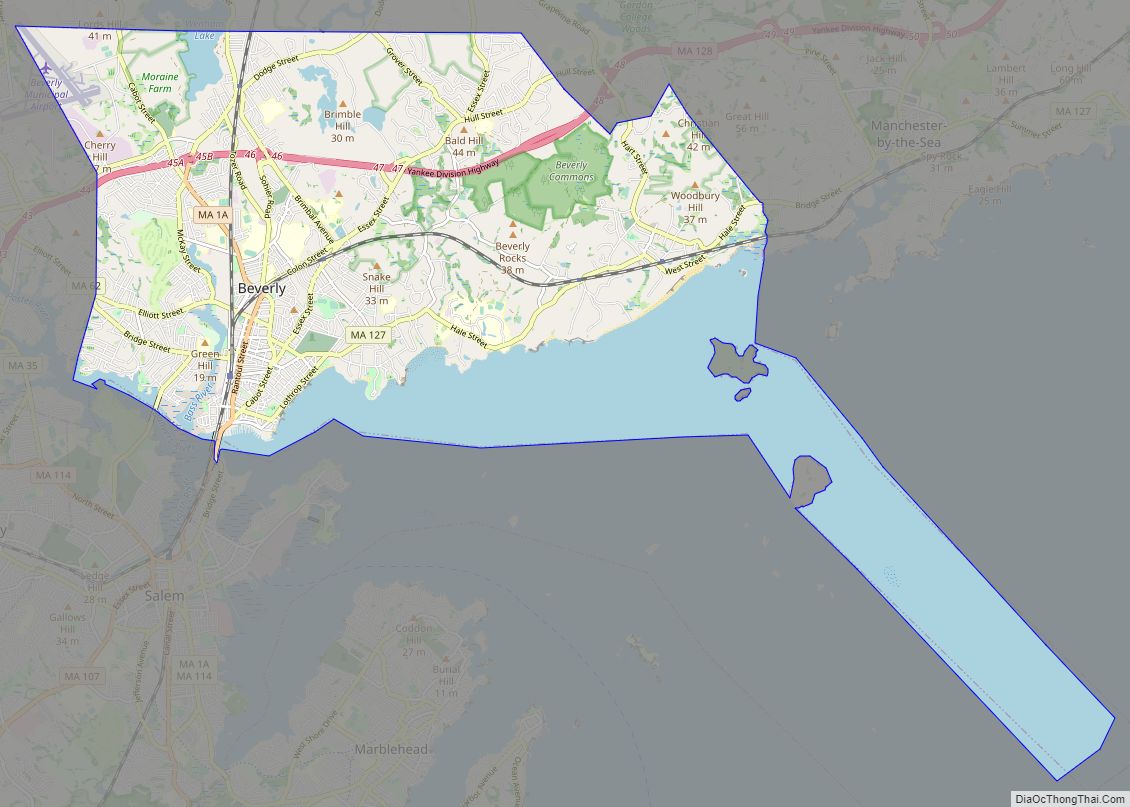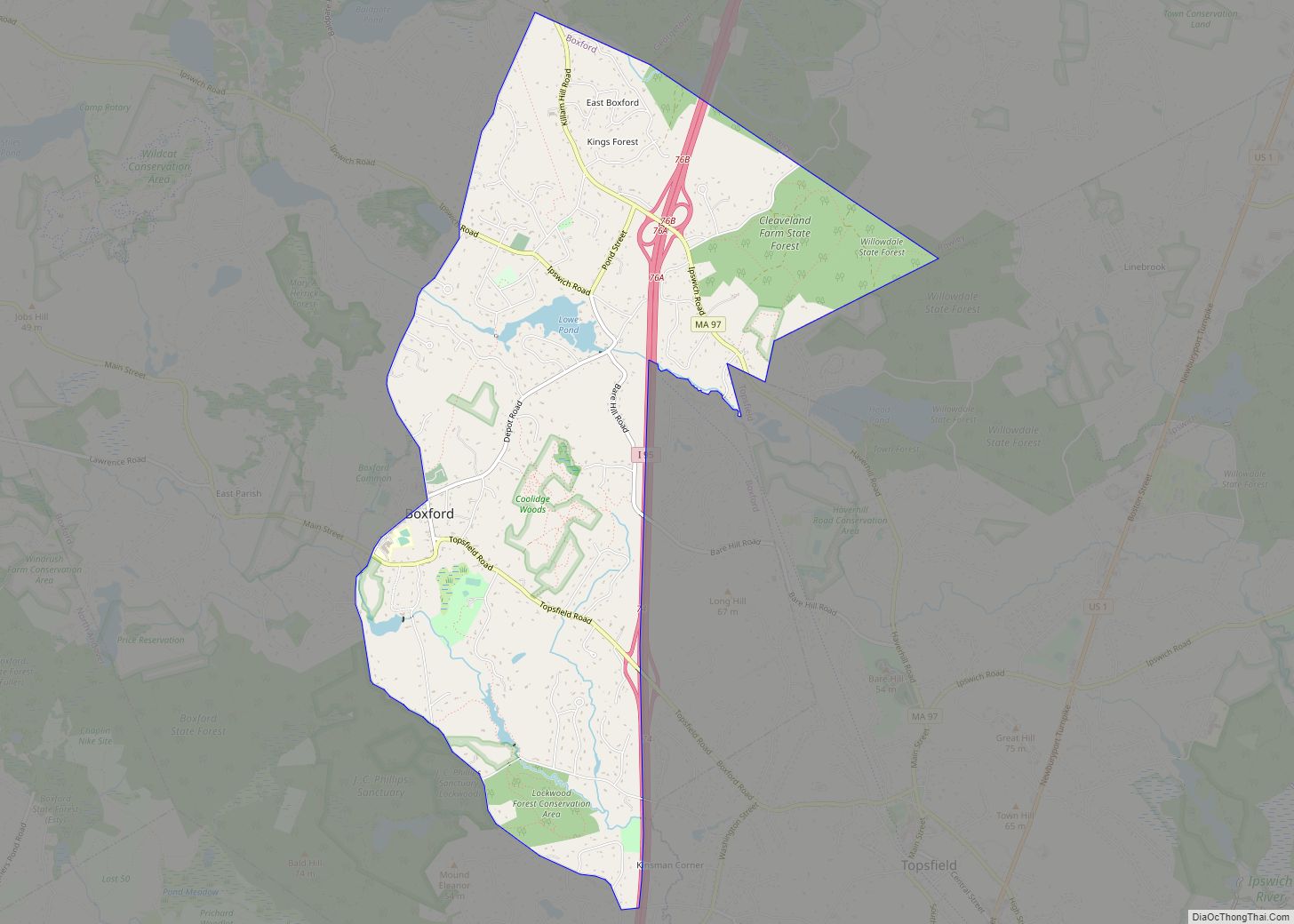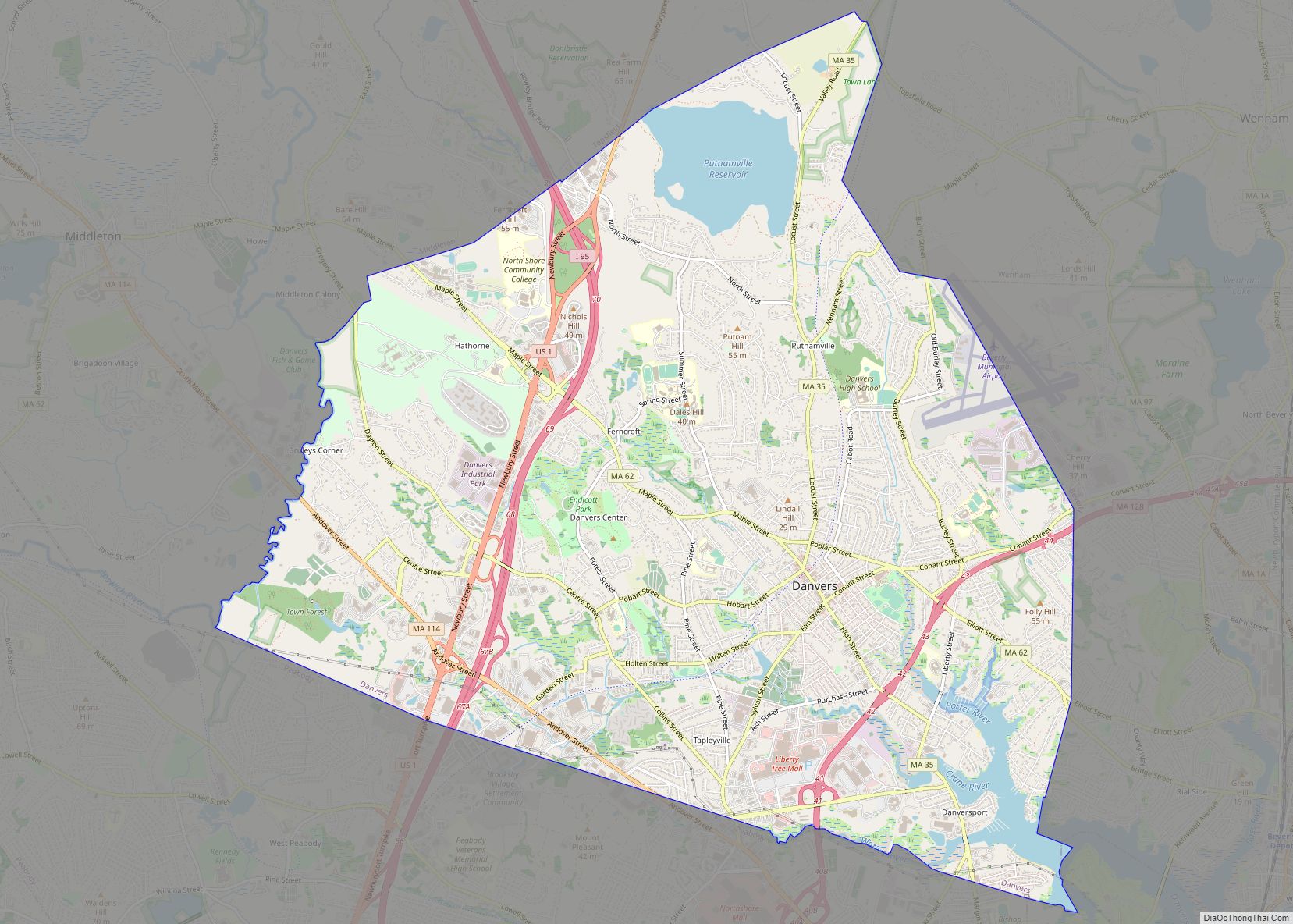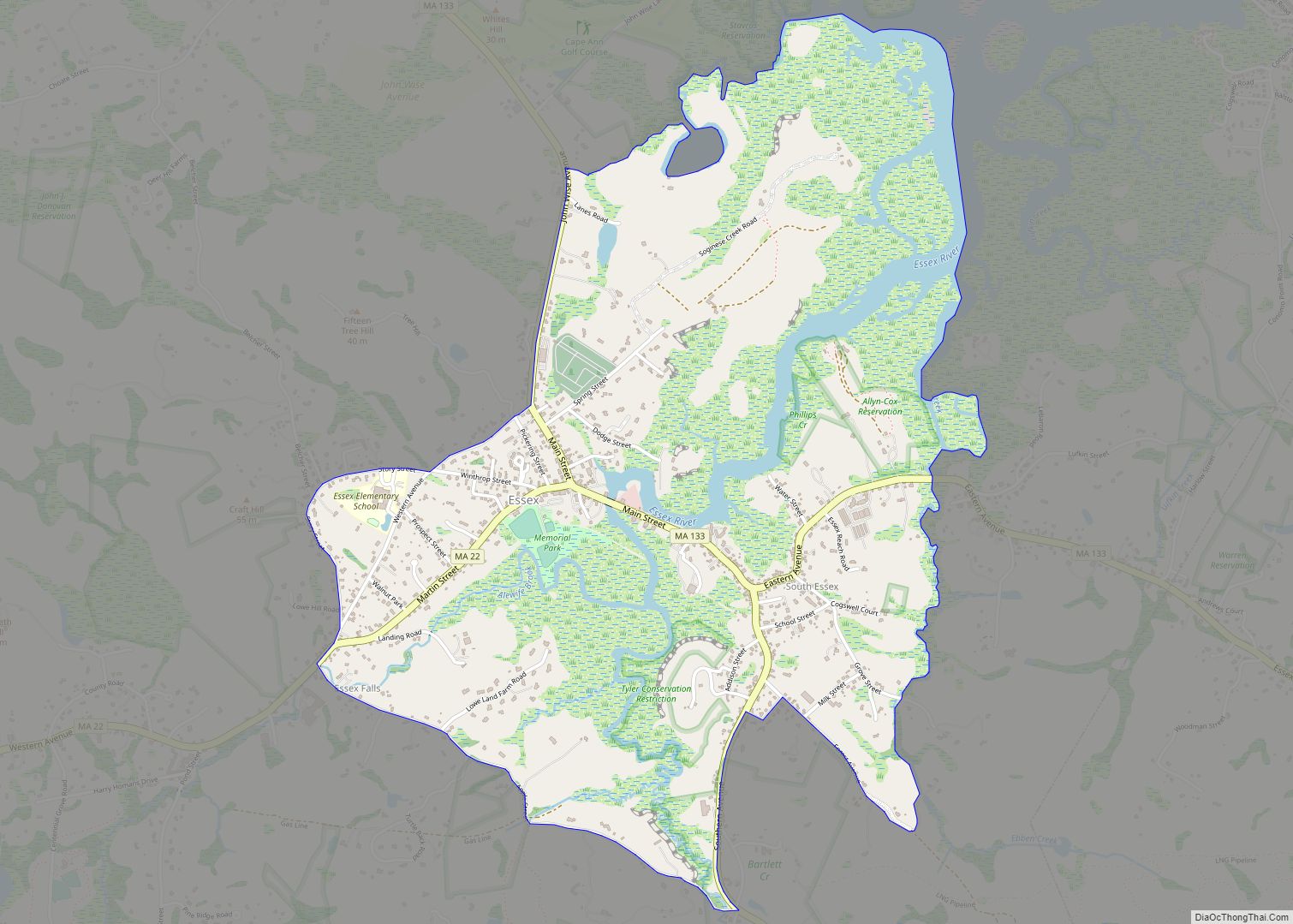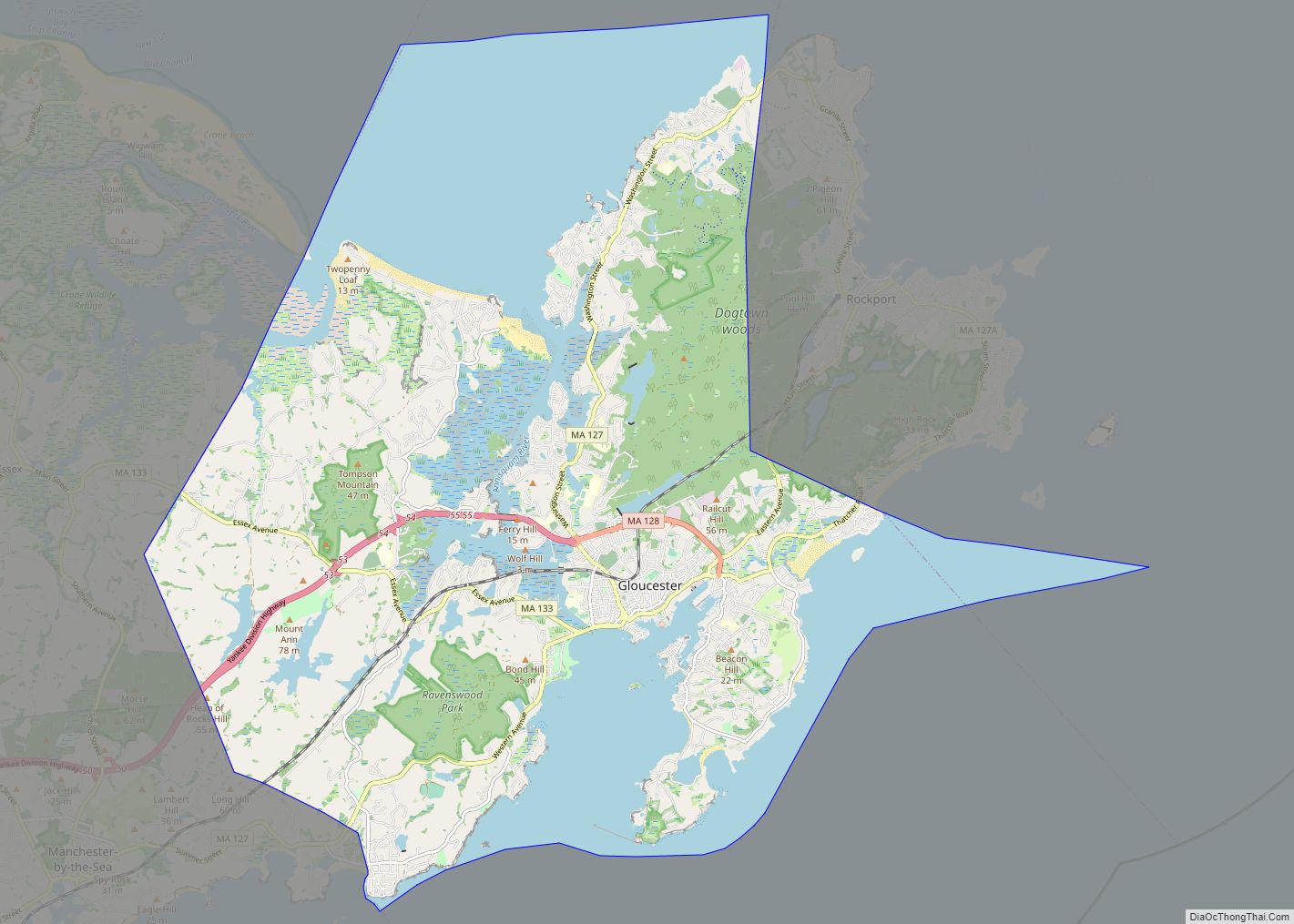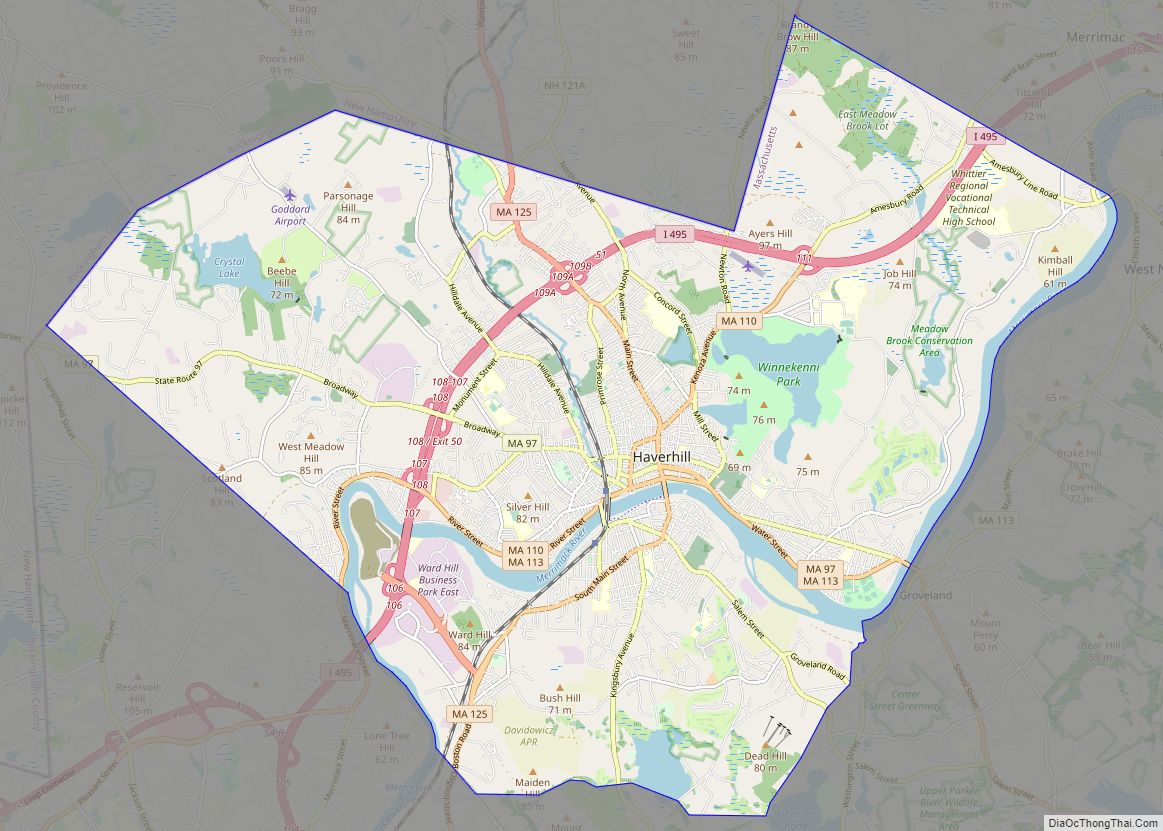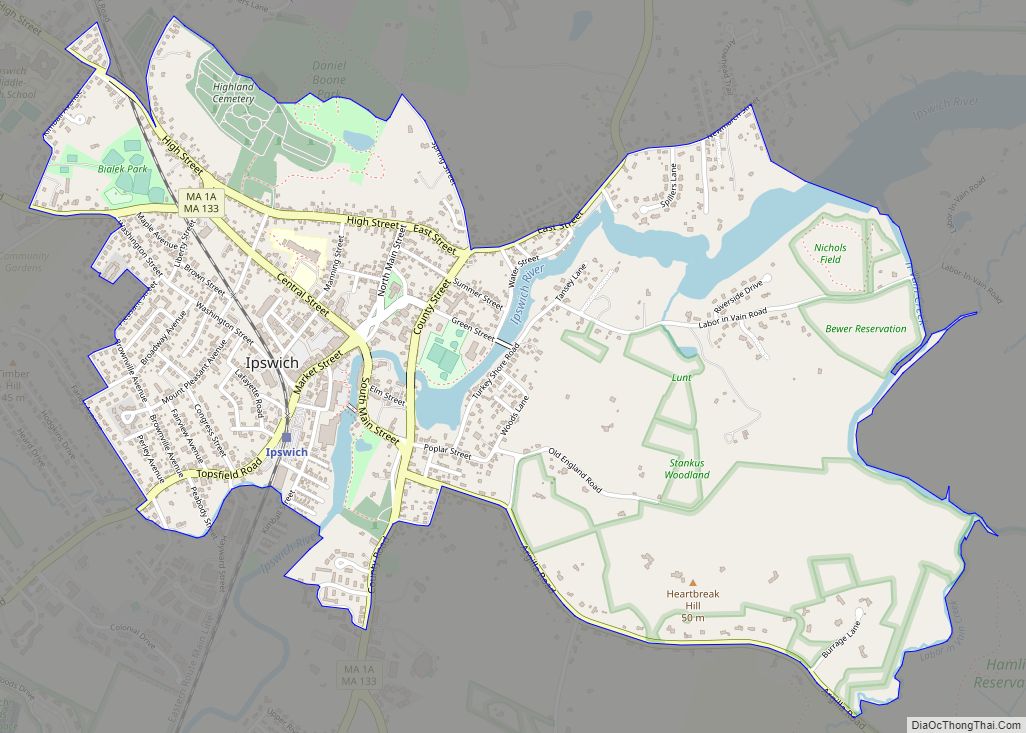Peabody (/ˈpiːbədi/) is a city in Essex County, Massachusetts, United States. The population was 54,481 at the time of the 2020 United States Census. Peabody is located in the North Shore region of Massachusetts, and is known for its rich industrial history.
| Name: | Peabody city |
|---|---|
| LSAD Code: | 25 |
| LSAD Description: | city (suffix) |
| State: | Massachusetts |
| County: | Essex County |
| Incorporated: | 1855 (town) |
| Elevation: | 17 ft (5 m) |
| Total Area: | 16.81 sq mi (43.54 km²) |
| Land Area: | 16.24 sq mi (42.05 km²) |
| Water Area: | 0.57 sq mi (1.49 km²) |
| Population Density: | 3,355.36/sq mi (1,295.54/km²) |
| Area code: | 351/978 |
| FIPS code: | 2552490 |
| GNISfeature ID: | 0614307 |
| Website: | www.peabody-ma.gov |
Online Interactive Map
Click on ![]() to view map in "full screen" mode.
to view map in "full screen" mode.
Peabody location map. Where is Peabody city?
History
The area was long inhabited by Native American people known as the Naumkeag.
The area was settled as part of Salem in 1626 by a small group of English colonists from Cape Ann led by Roger Conant. It was subsequently referred to as the Northfields, Salem Farms, and Brooksby. Several area residents were accused of witchcraft during the Salem witch trials of the late 17th century, three of whom were executed (John Proctor, Giles Corey, and Martha Corey).
In 1752, the area was set off from Salem, and incorporated as a district of Danvers. It was referred to as “the South Parish”, associated with a church located in present-day Peabody Square. In 1855, the community broke away from Danvers, and was incorporated as the independent town of South Danvers. The name was changed to Peabody on April 30, 1868, in honor of George Peabody, noted philanthropist born in present-day Peabody, widely regarded as the “father of modern philanthropy”. It was granted city status in 1916. The western, less densely populated area of town is often separately, yet unofficially, referred to as West Peabody.
Peabody started off as a farming community, but its rivers and streams attracted mills which operated by water power. In particular, Peabody was a major center of New England’s leather industry, which attracted immigrants from all around the world.
By 1915, a third of the population was born outside the United States. In addition to becoming home to large Irish and Russian populations, Peabody developed a large community of laborers hailing from the Ottoman Empire, mostly Turkish and Kurdish speakers from the region of Harput, now known as Elazığ. The population was situated primarily on Walnut Street, where they filled boarding houses and coffee houses to such an extent that it became known as “Ottoman Street,” and, more pejoratively and less accurately, “Peabody’s Barbary Coast”, as the United States was at war with the Ottoman Empire during World War I. One visitor even noted that signs in town were written in both English and Ottoman Turkish.
On the morning of October 28, 1915, twenty-one young children were killed in the St. Johns School fire in the downtown area on Chestnut Street. The cause of the fire is believed to have been arson. Their bodies were found after the fire subsided, huddled together and burnt beyond recognition, near the entrance just steps away from survival. As a result, Peabody became the first city in the United States to establish a law that all entrances or exits in public buildings be push-open, rather than by handle or knob.
The tanneries that lined Peabody’s “Ottoman Street” remained a linchpin of the city’s economy into the second half of the 20th century. The tanneries have since closed or been relocated elsewhere, but the city remains known locally as the Leather City or Tanner City. The mascot of Peabody Veterans Memorial High School is named the Tanners.
The loss of the tanneries was a huge blow to Peabody’s economy, but the city has made up for the erosion of its industrial base, at least in part, through other forms of economic development. Early in the 20th century, Peabody joined the automobile revolution, hosting the pioneer Brass Era company, Corwin Manufacturing.
The Northshore Mall, originally known as the Northshore Shopping Center, is one of the region’s largest shopping malls. The mall opened in September 1958 as an outdoor shopping center, and was built on farm land originally owned by Elias Hasket Derby, one of America’s first millionaires. Centennial Park, an industrial park in the center of the city, has attracted several medical and technology companies. West Peabody, which was mostly farm land until the 1950s, has been developed into a middle-to-upper class residential area. Brooksby Farm, a 275-acre (1.11 km) working farm and conservation area has been one of the city’s most popular destinations for decades.
Peabody is also the location of the Salem Country Club, a privately owned country club with a professional golf course, which hosted the U.S. Senior Open in 2001 and 2017, and the U.S. Women’s Open in 1954 and 1984.
City Hall in 1912
Peabody Square, c. 1906
Peabody Institute Library, c. 1912
Independence Greenway
The former tanneries of Peabody
George Peabody, the city’s namesake
Peabody Road Map
Peabody city Satellite Map
Geography
Peabody is located at 42°32′3″N 70°57′41″W / 42.53417°N 70.96139°W / 42.53417; -70.96139 (42.534045, −70.961465). According to the United States Census Bureau, the city has a total area of 16.8 square miles (43.5 km), of which 16.2 square miles (42.0 km) is land and 0.58 square miles (1.5 km) or 3.46%, is water. The northwestern border of Peabody lies along the Ipswich River, with brooks feeding it, and the Waters River, a tributary of the Danvers River, drains the northeast part of town. Several other ponds and a portion of Suntaug Lake lie within town. The largest protected portion of the city is the Brooksby Farm, whose land includes the Nathaniel Felton Houses.
The city is wedge-shaped, with the city center located in the wider southeast end. The neighborhood of South Peabody lies south of it, and the more suburban neighborhood of West Peabody, where the high school is, lies to the northwest of the city center, separated by the highways and the Proctor neighborhood. Peabody’s center is 2 miles (3 km) from the center of Salem, 15 miles (24 km) northeast of Boston, 18 miles (29 km) west-southwest of Gloucester, and 18 miles (29 km) southeast of Lawrence. Peabody is also bordered by Middleton to the northwest, Danvers to the north, Salem to the east, Lynn to the south and Lynnfield to the southwest.
See also
Map of Massachusetts State and its subdivision: Map of other states:- Alabama
- Alaska
- Arizona
- Arkansas
- California
- Colorado
- Connecticut
- Delaware
- District of Columbia
- Florida
- Georgia
- Hawaii
- Idaho
- Illinois
- Indiana
- Iowa
- Kansas
- Kentucky
- Louisiana
- Maine
- Maryland
- Massachusetts
- Michigan
- Minnesota
- Mississippi
- Missouri
- Montana
- Nebraska
- Nevada
- New Hampshire
- New Jersey
- New Mexico
- New York
- North Carolina
- North Dakota
- Ohio
- Oklahoma
- Oregon
- Pennsylvania
- Rhode Island
- South Carolina
- South Dakota
- Tennessee
- Texas
- Utah
- Vermont
- Virginia
- Washington
- West Virginia
- Wisconsin
- Wyoming
